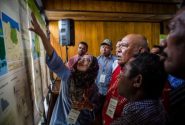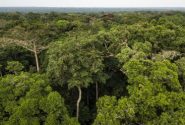
Addressing the drivers of forest clearing, such as agriculture, will directly result in emissions being reduced from forests. Ollivier Girard/CIFOR
DOHA, Qatar (27 November 2012)_For the first time scientists have assessed the main activities driving deforestation and forest degradation at the national level in most developing countries — providing essential information for countries negotiating climate change policies at this fortnight’s U.N. climate talks in Doha.
Agriculture was found to drive 80 percent of global deforestation.
“Addressing the drivers of forest clearing will directly result in emissions being reduced from forests,” said Gabrielle Kissinger from Lexeme Consulting and co-author of the synthesis report for REDD+ policymakers.
“A U.N. decision on drivers will signal to countries engaged in REDD+ how important drivers really are…and it is very important countries begin addressing this issue now if they want to meet their emissions reductions commitments.”
Until recently, few countries have been able to say exactly what proportion of deforestation was linked to agriculture, infrastructure, mining or logging due to a lack of data.
The report, one of the first to extensively look at global drivers on a country-by-country basis, found commercial agriculture to be the most important driver of deforestation in Latin America (causing 67 percent of deforestation), while timber extraction and logging activities dominated in Africa and Asia (causing 70 percent of deforestation).
Such findings are hoped to inform the negotiations on measuring and reporting of greenhouse gases (MRV) in REDD+, an area that many expect will be finalised by the end of next week.
“Understanding what is driving changes in your forest, both now and in the past, is important in developing reference emissions levels for REDD+ so we consider national circumstances and underpin scenarios that deviate from historical trends,” said Martin Herold, a scientist with Wageningen University and associate with the Center for International Forestry Research (CIFOR).
“However very little work has been done on how to analyse greenhouse gas emissions from drivers because the required national and local data is often not easily available.”
A U.N. decision on drivers of deforestation will signal to countries engaged in REDD+ how important drivers really are in combating carbon emissions.
“Addressing the drivers of forest clearing will directly result in emissions being reduced from forests,REDD+ is a climate mitigation scheme that provides financial incentives to developing countries to avoid greenhouse gas emissions associated with forest clearing. The long-term viability of the scheme depends on altering business-as-usual activities that cause land clearing and greenhouse gas emissions from forests.
These activities, or drivers of deforestation, are classified as either direct or indirect. Direct drivers are human activities that directly alter forest cover such as urban expansion, infrastructure, mining, logging or agriculture. Indirect drivers are complex international and national processes that influence human activities, such as changes in economic growth, population growth, commodity prices and governance.
“All of these forces conspire together to influence forest clearing,” said Kissinger.
Drivers of deforestation were first mentioned in the 2010 UN climate talks in Cancun where the issue was incorporated into the work program of the UNFCCC’s scientific advisory group (the Subsidiary Body for Scientific and Technological Advancement or SBSTA) for further investigation prior to the meeting in Doha.
It is unclear whether SBSTA will report back to the Parties with guidance on drivers of deforestations and forest degradation in the next fortnight, as was expected, said Herold.
“SBSTA is expected to develop guidance on how to assess and address drivers of deforestations and forest degradation in the context of REDD+, however there are doubts that this important issue can be tackled by SBSTA here in Doha comprehensively. As a minimum it should be put on the agenda for the upcoming negotiation sessions.”
Many REDD+ countries are already starting to identify and measure direct drivers through remote sensing and ground data, tracking the impact of activities on forest carbon stocks over time and informing strategies to reduce the impact of these activities as part of there REDD+ readiness process.
However Veronique De Sy, co-author of a recent CIFOR study, stressed that more national information on drivers was still needed.
“The information we have gathered so far shows that the availability of quantitative data on drivers is variable and information is still not certain in many countries’ cases,” she said, noting that only 12 percent of the countries studied were able to provide quantitative data.
Meanwhile, the demand for an even more accurate forest monitoring system is growing, she and others have said.
“This study provides a coarse way to fill this data gap with a current best estimate for countries without data. But there is a need to invest in assessing drivers at an even more thorough level.”
Despite the challenges, scientists believe their findings can help governments develop more targeted policy measures to tackle the specific drivers of deforestation and land degradation, through a mixture of incentives and disincentives and enabling measures at the international, national and regional levels.
“A lot of countries in their REDD+ plans are specifically asking for international guidance on land use change…they’re looking for tools, such as finance, to help them change driver activity.”
And the inclusion of drivers in a U.N. decision may also help secure financing for REDD+, said Kissinger.
“Countries specifically want to see finance directed towards addressing drivers. By affecting drivers, that is really where you are going to see payments based on emissions being reduced.”
With additional reporting by Andrea Booth.
We want you to share Forests News content, which is licensed under Creative Commons Attribution-NonCommercial-ShareAlike 4.0 International (CC BY-NC-SA 4.0). This means you are free to redistribute our material for non-commercial purposes. All we ask is that you give Forests News appropriate credit and link to the original Forests News content, indicate if changes were made, and distribute your contributions under the same Creative Commons license. You must notify Forests News if you repost, reprint or reuse our materials by contacting forestsnews@cifor-icraf.org.
Further reading
An assessment of deforestation and forest degradation drivers in developing countries.
Drivers of Deforestation and Forest Degradation: a synthesis report for REDD+ policymakers
The economic determinants of land degradation in developing countries
Reference emissions levels decision helps forested nations step closer to REDD+












